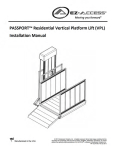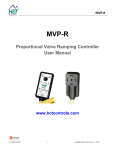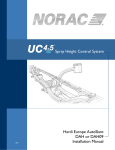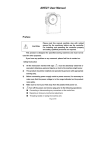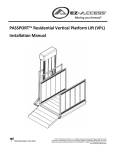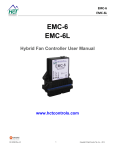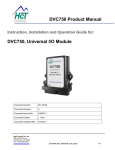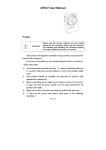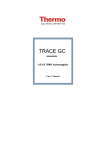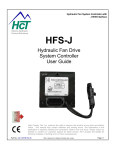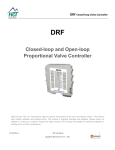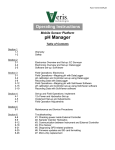Download Electronic Pump Controller: epc-2
Transcript
High Country Tek, Inc. Electronic Pump Controller: epc-2 Open Loop control of single or dual coil pump Compensators & Strokers Electronic Control Solutions for the Global Fluid Power Industry High Country Tek, Inc. ( HCT ) is the Fluid Power Industries premier Independent electro-hydraulic controls supplier with best in class products, service and training. HCT provides the most ‘Ruggedized’ electronic control solutions for a wide variety of applications that are successfully applied across the globe in all areas of the fluid power industry. To compliment our epc-2 controller, HCT has released a free software application that allows immediate operation of the controller with two separate channels, each offering the opportunity to control dual solenoid projects. For further system optimization, a free pre-written Graphical User Interface (GUI) for use with Windows based PC’s or the HCT TekBook, allows the user to fine tune the various parameters typically seen in an open loop controller of this type. Standard HCT Product Features: Dual channel open loop controller ready for voltage or mA analog command signals Operates with all major OEM electro-hydraulic valve and pump equipment Sealed & protected to >IP68 ( NEMA 6P ) Environmentally hardened by ’Solid’ potting with flame retardant materials SAE J1939 & HCT-CAN communication protocols Full CE compliance for confident global application on all mobile equipment SAE J1455 for ‘Load-dump’ protection Patented Intella™ system configuration software for fast implementation Industry standard Cinch or Metripack 30 way connectors used Comprehensive on-line literature, manuals, user guides and application information www.hctcontrols.com Electronic Controller Solutions for the Global Fluid Power Industry Application Overview: The epc-2 controller allows the user to connect, calibrate and immediately use two separate input and output channels in one controller, making it ideal and very cost effective for controlling up to two (2) individual open loop pump compensator or stroker control solutions. The controller operates from a wide supply range of +10 to +32VDC so one unit can interface with any OEM coils of either 12VDC or 24VDC with a current maximum requirement of up to 3amps per coil. Industry standard 0-5VDC or 4-20mA command signals can be selected, making this a very flexible unit for mobile or industrial application usage. The PC based user interface is designed around three easy to navigate pages that allow the user to quickly configure and set-up the module to cost effectively control one or two separate pumps from one controller Installation Guidelines: ALWAYS do the following: Take a few minutes to FULLY read THESE information / data sheets BEFORE starting. Keep High Voltage AC cables separate from Low Voltage DC signal and supply cables. Make sure the units supply voltage is the same or greater that the coils on the valve(s) being driven ! Check the units supply voltage is CORRECT, ‘ ELECTRICALLY CLEAN ’ and STABLE. Ensure that you are aware of the adjustments and consequences on the electronics and hydraulics. Make sure you have the correct tools to do the intended job ( i.e. Tekbook, P.C., software ) e.t.c. ‘Isolate’ this unit from all other equipment BEFORE any form of welding takes place. Check ALL wire connections to and from this unit to ensure NO short or OPEN circuits are present. Operate the units within specified operating temperature for best & reliable performance. Ensure that any unused wires / terminals are terminated safely and not shorted together. Isolate the controller if ANY form of battery charging or battery boosting takes place on the vehicle. Ensure that any HCT recommended fuses, circuit breakers or safety devices are fitted as required Ensure ALL valve connectors are wired correctly, secure, locked and connected to correct coils. Observe the set-up procedures in this manual for best operational results. Follow and abide by local and country health & safety standards – protect yourself and others ! NEVER do the following: Operate this unit without the recommended fuse as required by HCT Arc Weld or Charge Batteries with this driver unit connected as damage can occur. Attempt to use this unit if you are unsure of electrical OR hydraulic connections or expected operation. Attempt to use this unit in Areas where other AC or DC coils HAVE NOT been fully suppressed. Use a power supply that is not rated for the correct required O/P current under full load. Allow wires TO or FROM the unit to short circuit ( to each other or chassis/cabinet e.t.c. ). Attempt to use this unit in areas of intense RF without adequate screening measures. Disconnect or connect wires to or from this unit unless it isolated from the power supply. Use this unit in temperatures that exceed those specified as operation may be effected. Start this unit without ensuring ALL work areas are clear of personnel ! If you are unsure about any part of the controller wiring or installation, contact local professionals or High Country Tek Inc. technical support for guidance BEFORE you apply power or damage the controller or application. 2 Electronic Controller Solutions for the Global Fluid Power Industry epc-2 & evc-2 Specification Overview ( General ): 1. Module size/format: High Country Tek Inc. Mobile ‘easy-mount’ format 2. Design Standards: Full CE classification 3. Power Supply type and range: 10 to 32VDC (max) 4. Recommended module protection: 5A AGC fuse in power supply line 5. User stabilized voltage: + 5VDC ±10% 6. Output current: 500mA (max) 7. Protection: Current limited, short circuit protected 8. Digital Input number: 3x ON/OFF inputs 9. Digital Input type: DCV - level shift 10. Digital input values: 0V to +VPower supply max 11. Universal input number: 2x inputs 12. Universal input type: DC voltage or DC Current 13. Universal input values: 0 to +5v or 4 to 20mA 14. Voltage Command I/P Impedance: 10 KOhm 15. Current command shunt resistor value: 100 Ohms 16. Proportional Output number: 2x PWM 17. Protection: Open and short circuit protection 18. Proportional output Current: 0 to 3 amps max 19. Digital Output number: 6x High Side 20. Digital output type: ON/OFF level shift 21. Proportional output Current: 0 to 3 amps max 22. Protection: Open and short circuit protection 23. Digital output values: 0V to +V module supply voltage -0.5VDC 24. Operating Temperature range: -40C to +85C 25. Storage temperature range: -40C to +100C 26. Ingress protection rating: IP 68 / NEMA 6P 27. Connector type: Metri-Pack 30 way male Contact HCT customer service or your nearest HCT Product distributor for other connection/Hardware configurations if required REMOTE ENABLE Important Note: The Enable input is DIGI 1 ( connector pin S2 ) and is configured to be active HIGH The user MUST pull the input ‘S2’ to +V supply to allow normal operation. The enable input is failsafe, with the input pin ‘S2’ pulled LOW ( 0V ) internally. 3 Electronic Controller Solutions for the Global Fluid Power Industry Dual Path epc-2 & evc-2 Graphical User Interface (GUI) Guide: 1. 2. 3. 4. 5. Install user interface program onto Windows PC or laptop or HCT TekBook following the on-screen instructions Connect epc-2 controller to suitable, stabilized power supply (10-32VDC) Connect RS232 communications cable to epc-2 and Windows PC noted in 1 Locate the epc-2 program in the PC ‘START’ menu and click to open Once started, the program will open with the screen shown to the left and attempt to make communications with the epc-2 module NOTE: As required, messages will be displayed to alert the user to issues or items that need attention. Typically GREEN message backgrounds are good while bright RED should be taken as a warning or notice of a setting or state that could need attention. This screen gives the user a ’Dashboard View’ of the controller settings and operation in one easy to read screen. The module communications status RX and TX lights will alternate red/green when in communication, while the module supply voltage and internal temperature can also be seen in the middle box. The boxes lower left and right display the ‘Command Input’ and ‘Output Current’ for channel one and channel two as well as which coil (A or B) is being driven at any time. The single light bar at bottom middle, will be RED = ‘Driver disabled’ or GREEN = ‘Driver enabled, to show the status of the global enable input and all outputs ( proportional AND digital ) on the module. Clicking the ‘Next >>‘ button will move the user to the next screen or clicking ‘Exit’ will close the interface and return the user to Windows desktop. The ‘Configuration Page’ allows the user to set the command signal type to either DC Voltage (0 to +5VDC) or Current (4 to 20mA) and also to single or dual coiled valve drive configuration on the pump being controlled. Selecting a single coil gives the full command signal over the output current, while selecting a dual coil, immediately offsets the command to give mid value for zero drive to each coil. The ‘Current P’ and ‘Current I’ settings allow the user to optimize the response of the controller to any type or make of valve being driven - see page 11 for guidelines. Clicking the ‘Next >>‘ button will move the user to the next screen or clicking ‘<< Back’ will take the user to the previous screen. The ‘Fine Tune Page’ offers the user options to customize each channel and to ensure that the pump reacts as desired and is optimized - see page 6 for details. As long as the user is connected to a epc-2 module, any changes made here are transmitted immediately to the module and will change the characteristic in the non-volatile memory updating the settings and making them the new levels even after power ON/OFF, so care should be taken to make small changes while also making sure that the correct parameter is being altered. User editable value box’s have a blue background with yellow text. Each window has ‘min’ and ‘max’ limits pre-set so prevent the user from entering a value that may cause issues. Clicking the ‘Dashboard‘ button will move the user back to the observation screen or clicking ‘<< Back’ will take the user to the previous screen. 4 Electronic Controller Solutions for the Global Fluid Power Industry Dual Path epc-2 & evc-2 Graphical User Interface (GUI) Guide: Cont... Click the following for these functions: Technical: This will open a PDF version of this manual that is installed with the Graphical User Interface software so it is available as a reference at all times. Contact: This opens the users E-mail program and enters the HCT address and subject ready for the user to communicate and send whatever information required to HCT. About: Opens the ‘Miscellaneous Information’ page displayed below, giving important information on the module and versions of software that may be needed during any conversations or E-mail with HCT technical or field support personnel. Help: This opens a PDF document on the epc-2 going into more details on the programming that the user can utilize to modify this original application software program if required ( GUI will NOT reflect any user changes made ) The ‘Miscellaneous Information’ page shows the module serial number as well as all versions of the software and GUI being used. This information may be asked for by HCT support personnel during any contact you require for help and guidance e.t.c. The other information shown on this page is the HCT mailing address and also the direct E-mail to our customer support group. There is also a live link ( if PC is connected to the Internet ) to the HCT website where extra information as well as the latest literature and product details can be found as required. Clicking the ‘Back >>‘ button will take the user to the previous screen. PC to epc/evc-2 connections: USB to RS232 Adaptor: In the event that the PC does NOT have a 15 way Serial Port ‘D’ connector, a high quality, broad band USB to RS232 adaptor must be used. For best results, only use adaptors recommended, tested and approved by HCT. Please contact our customer service department to discuss your needs if required. To use the set-up program described above, the user must connect a communication cable between the epc/ evc-2 and the user PC. This is achieved by using an HCT supplied RS232 cable that will allow direct connection between a 15 way Serial Port ‘D’ connector on the PC and a polarized 4 way tower WeatherPack connector. HCT Part Number: HCT Part Number: 999-10075 108-00119 See page 8 for connection details 5 Electronic Controller Solutions for the Global Fluid Power Industry epc-2 & evc-2 User Interface ‘Fine Settings Page’ Guide: 1. Channel X coil 1A Imin Out Current ( mA ): Minimum value allowed = 0mA This is the minimum current value that that will be sent to valve coil 1A when the command signal is approximately ± 5% of 2.5V (~125mV) 2. Channel X coil 1A Imax Out Current (mA): Maximum value allowed = 3000mA This is the maximum current value that that will be sent to valve coil 1A when the command signal is at approximately ±100% i.e. 0% command = Coil B at 100%, 50% command - Both coils OFF, 100% command = Coil A at 100%. 3. Channel X coil 1B Imin Out Current (mA): Same function and action as noted in item 1. above 4. Channel X coil 1B Imax Out Current (mA): Same function and action as noted in item 2. above 5. Channel X coil 1A Ramp UP time ( Seconds ): Minimum value allowed = 0 seconds - Maximum value allowed = 65 seconds This is the total time taken for the output current to go between the Imin and Imax settings for a 0% to 100% command input. The time is scaled for 0 to 100% command meaning that if the command goes from 50% to 100% the time taken will be 50% of the seconds set. 6. Channel X coil 1A Ramp DOWN time ( Seconds ): Minimum value allowed = 0 seconds - Maximum value allowed = 65 seconds This is the total time taken for the output current to go between the Imax and Imin settings for a 100% to 0% command input. The time is scaled for 0 to 100% command meaning that if the command goes from 100% to 50% the time taken will be 50% of the seconds set. 7. Channel X coil 1B Ramp UP time ( Seconds ): Minimum value allowed = 0 seconds - Maximum value allowed = 65 seconds Same function and action as noted in item 5. above 8. Channel X coil 1B Ramp DOWN time ( Seconds ): Minimum value allowed = 0 seconds - Maximum value allowed = 65 seconds Same function and action as noted in item 6. above 9. Channel X Dither Amplitude: Minimum value allowed = 0% - Maximum value allowed = 100% ( in 10% increments ) This is the level of ‘Dither’ signal applied to the output current as a fixed percentage - i.e. if you set 50% here, the amplitude will be ratiometric over the entire PWM output range of 5 to 95 PWM. Valve OEM’s usually recommend a % level here If no information is available, set to 30% for initial trials and optimize at later stage if needed. 10. Channel X Dither Frequency ( Hz ): pre-set values - 33, 45, 50, 55, 76, 100, 125, 142, 200, 250, 333 & 500HZ This is the ‘Dither’ frequency that will be on the PWM output. Valve OEM’s usually recommend a frequency here, if no information is available, initially set 140Hz - 250Hz for cartridge and smaller valves and 100Hz - 140Hz for larger industrial valves. 11. Channel X Command Min: The value entered here, sets the Minimum command input allowed. Below this value, the respective epc-2 proportional output is disabled 12. Channel X Command Mid: The value entered here, sets the Mid command for crossover in dual coil mode, ignored for single coil mode 13. Channel X Command Max: The value entered here, sets the Maximum command input allowed. Above this value, the respective epc-2 proportional output is disabled 6 Electronic Controller Solutions for the Global Fluid Power Industry Dual Path with Single coil connections: ( see Appendix A for output graphs ) REMOTE ENABLE : See note on page 3 of this manual REMOTE ENABLE : See note on page 3 of this manual epc-2 epc-2 Configuration shown using 2x potentiometers or joysticks with internal regulated +5V to control 1x valve coil per channel. Configuration shown using 1x potentiometer or joystick with internal regulated +5V and 1x externally provided 4-20mA command input to control 1x valve coil per channel. Dual Path with Dual coil connections: ( see Appendix A for output graphs ) REMOTE ENABLE : See note on page 3 of this manual REMOTE ENABLE : See note on page 3 of this manual epc-2 epc-2 Configuration shown using 2x potentiometers or joysticks with internal regulated +5V to control 2x valve coil per channel. Configuration shown using 1x potentiometers or joysticks with internal regulated +5V and 1x externally provided 4-20mA command input to control 2x valve coil per channel. 7 Electronic Controller Solutions for the Global Fluid Power Industry Additional ON/OFF control features: To allow low level signals to drive high current loads ( i.e. lamps/alarms ) , the application provides 2 extra ON/OFF drives for convenience: Digi 2 ( Connector pin S3 ) is internally connected to HS 5 ( Connector pin W3 ) Digi 3 ( Connector pin T3 ) is internally connected to HS 6 ( Connector pin X3 ) epc-2 Module connection details: epc‐2 Connector Designation Tables 999‐10075 Connector Details 30 Pin Metri‐Pak Connector ( Male, Plug ) RS232 (PC) to epc‐2 Communication Cable PIN L1 L2 L3 Name TXD RXD RTS Function Transmit RS232 Data ‐ Pin 'C' Receive RS232 Data ‐ Pin 'A' Request To Send ‐ RS232 Pin 'D' M2 M3 PWR COM RS232 GND/0V PWR COM Channel #2 Command GND/0V N2 N3 P1 PWR COM Ground / 0V / Signal Common PWR COM Ground / 0V / Signal Common UNI‐1 Channel #1 Command I/P PIN Name P3 R1 PWR COM Channel #1 Command GND/0V UNI‐2 Channel #2 Command I/P Function R3 +5V USER +5V regulated user output S2 S3 T1 T2 DIG‐1 DIG‐2 HS‐1 HS‐3 Global Enable I/P Digital I/P #2 ( Turns ON W3 ) Channel #1 Coil A Channel #2 Coil A PIN T3 W1 W2 W3 X1 X2 X3 Y1 Y2 Name DIG‐3 PWM‐1 PWM‐2 HS‐5 HS‐2 HS‐4 HS‐6 +PWR IN‐1 +PWR IN‐2 Function Digital I/P #3 ( Turns ON X3 ) Chanel #1 PWM O/P Chanel #2 PWM O/P Digital O/P ( from Digi 2 I/P ) Channel #1 Coil B Channel #2 Coil B Digital O/P ( from Digi 3 I/P ) +V Supply Power Input +V Supply Power Input evc‐2 PIN L1 L2 L3 M2 Name TXD RXD RTS PWR COM Function 999‐10076 C Transmit RS232 Data ‐ Pin 'C' A Receive RS232 Data ‐ Pin 'A' D Request To Send ‐ RS232 Pin 'D' B RS232 GND (0V) HCT Part Number: 999-10075 LED operation and description: 8 Electronic Controller Solutions for the Global Fluid Power Industry epc-2 Module Mechanical Details: IMPORTANT NOTE: Recommended tightening torques for the securing bolts are as follows: For a 1/4-20 bolt, SAE Grade 5 DRY Torque: 8 Ft-Lbs Lubricated Torque: 6.3 Ft-Lbs 9 Electronic Controller Solutions for the Global Fluid Power Industry ‘P’ and ‘I’ settings: The P & I setting boxes ( circled in orange, Left ) for each channel are factory pre-set to P = 10 and I = 10 default values ( = gain/time of ~0.16 ) P & I max values allowed: The window only allows the user to enter from 0 to 255 max values in whole numbers. The P & I operation in the DVC is scaled such that 255 is equivalent to a gain of 4, with 64 equaling a gain of 1 These default values allow the majority of proportional coils/valves/pumps to operate normally and meet expected product OFF to ON and ON to OFF times. Always return to these values if the system needs to be reset. If it is found that the coil/valves/pumps is not responding as desired, the user may change the values in each box by selecting the window with the PC mouse and entering a new number. The ‘P term’ affects the amount of output current change relative to the output current error value that is derived from the scaling of the command signal to the Imin & Imax settings. Increasing the value makes the change more aggressive for a smaller error. Too aggressive a change can cause the valve/pump to oscillate ( Under-damped ) , too low a value setting will result in slow response ( Over-damped ). The ‘I Term’, affects the output current error correction time . Increasing the value too much can result in the error being corrected too slowly to matter ( Over-damped ), too small a value can result in corrective current overshoot and multiple iterations until stable ( Under-damped ). Settings for P & I are also effected by the system configuration, capacity and even viscosity changes, so the ideal setting is when the coil being driven responds as the manufacturers specification regarding slew rates for rise and fall times and delivers the system performance needed for a successful application. P & I Set-up Guide: 1. Always start running the system using the default P & I settings as supplied to get a base line of operation 2. Use a fast changing command signal with small demand changes to see reaction ( use square wave if possible ) 3. If better response is needed, start to increase the ‘P’ setting first, in SMALL increments ( increase by count of 5 ) 4. Test system response by using method described in 2. above - readjust as needed to get required response 5. Once the P is set, start to adjust the I setting to get current output stability and system response as required. NOTE: Because system characteristics change with oil temperature, viscosity, hose lengths and loading, It is important when setting P & I values different to the defaults provided, that the user tests the command signal to output stability over a wide range of settings to ensure the best possible stability and response has been achieved. 10 Electronic Controller Solutions for the Global Fluid Power Industry Appendix A: Dual Path with Single coil connections This option allows each input to control one output channel and take full advantage of the 10 bit ( 1024 steps ) resolution offered by the epc-2controller. The dead band is internally set to approx. ±5% of the chosen command, shown here at 250mV for a 5V input and is to allow for any mechanical wear, tolerance or movement in the command potentiometer or joystick. When using 4 to 20mA, the deadband is still ±5% which equates to approx. 0.8mA Appendix A: Dual Path with Dual coil connections This option allows each input to control one output channel but two valve coils. The input command signal is configured such that at ~mid-value, both coils are OFF. The command dead-band is internally set to ±5% as before and as soon as this level is seen, the output immediately jumps to the relative Imin setting and smoothly proceeds from there to Imax for max command. Coil A command is from ~mid value to +max value ( i.e. 2.5V to +5VDC ) while Coil B command is from ~mid value to +0 value ( i.e. 2.5V to 0V ). Input /Output Function Curve: The epc-2 has the patented HCT I/O curve function integrated into the application software and is available to allow the user to change the relationship between input command and output current to something other than linear if required. This unique feature give precise optimization of machine control needs when options such as ‘creep’ and ‘full speeds’ are needed from a single manual joystick movement. This adjustment has restricted access to avoid any issues with standard operation but can easily be changed by a qualified HCT Intella™ software programmer user using the free HCT Program Loader Monitor (PLM). Please contact the HCT customer service or your local distributor for details on how to access this feature or to find your nearest qualified Intella™ software programmer. 11 Electronic Controller Solutions for the Global Fluid Power Industry Services and Resources: Mining & Exploration Agriculture Cranes & lifts Refuse & Recycling Construction Off-Road vehicles Forestry, Wood & Pulp Reclamation & Salvage Oil Field & Sands Demolition Equipment Cooling Solutions Military Apparatus Specialty Use Remote Control HCT Product Sales and Support: Power Generation Emission Controls Integrated Drivers For a full list of authorized distributors worldwide, please visit: Valve & Pump Controls www.hctcontrols.com/distributors/index.htm For more information: Customer Service: To discuss anything in this brochure, order product, get price and delivery or book a training course, please send an e-mail to us at: [email protected] www.hctcontrols.com High Country Tek, Inc. 208 Gold Flat Court Nevada City, CA, 95959 Tel: (1) 530 265 3236 Fax:(1) 530 265 3275 021-00222, epc-2, Rev B.pub/GG/11 12 Copyright © High Country Tek, Inc. - 2012















